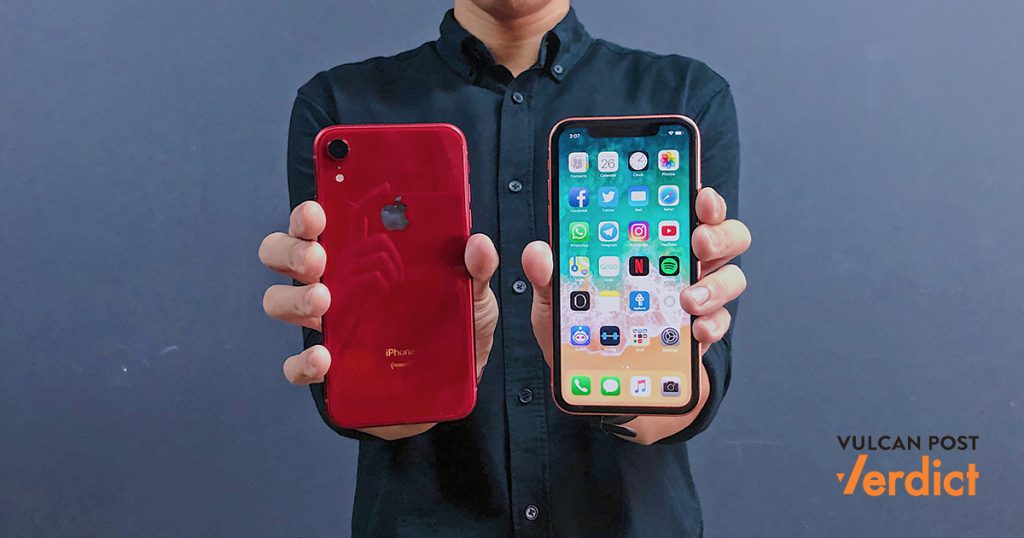- The iPhone XR was released last September, alongside the iPhone XS and XS Max.
- After using it with three months, just how different is it from Apple’s flagship phones?
Smartphones have always been expensive, but 2018 was the year where they got really, really expensive.
The base model of the iPhone XS, for example, costs more than S$1,600/RM4,999, and even the flagship phones of “cheaper” brands have risen to upwards of S$1,000 too.
Not everyone is willing to shell out that kind of money for a phone, and that’s probably why Apple created the iPhone XR. This mid-range option loses some features of its big brother, but also comes with a smaller price tag for more budget-conscious consumers.
After using it for the past three months, is the XR a worthy alternative to the XS?
And more importantly, is it still worth buying in 2019? Let’s find out.
Same Same, But Different

At first glance, the iPhone XR looks just like its more expensive counterparts, but there are a few subtle differences.
First up is its size — at 6.1 inches it sits somewhere between the 5.8-inch XS and 6.5-inch XS Max, and while I initially thought that it might be awkward to hold, the difference actually isn’t that noticeable when you have it in your hands.
What is noticeable, however, is the display.
Unlike the Super Retina OLED screen on the XS and XS Max, the XR uses a Liquid Retina LCD screen instead.
This is probably fine if you’ve been using an iPhone 8 or earlier, but as someone who’s used the iPhone X before, there’s a noticeable drop in sharpness and image quality.
It’s What’s Inside That Counts

While the exterior of the iPhone XR is just…okay, the internals are where things start to get interesting.
Surprisingly, the XR is equipped with the same A12 Bionic Chip that’s found in the XS and XS Max. This means that performance-wise, the XR performs just as efficiently as Apple’s flagship phone.
And seeing that the A12 Bionic is Apple’s latest and greatest, it’s about as good you’d expect. Navigating through your phone is noticeably smoother, and apps load a little faster as well.
Another notable upgrade is the speakers. Traditionally, iPhones only produce sound from one side of the phone, but the XR now has channels on both the left and right.
This creates a cool surround sound effect, and makes watching videos, listening to music, and playing games better than ever if you’re upgrading from an older model. This is obviously hard to articulate in words, and one feature that you’ll probably have to try out for yourself to understand how significant it is.
Lastly, the battery a pleasant surprise — because an LCD screen consumes less power than an OLED, the iPhone XR actually outperforms the XS in terms of power efficiency.
If a lasting battery is top priority, then the iPhone XR could actually be the better choice.
No Telephoto? No Problem.

On the camera side of things, the iPhone XR comes with a single 12 megapixel wide-angle camera.
Even though it’s lacking the telephoto lens found in Apple’s flagship phones, it’s more than serviceable for general use. In my experience, photos came out vivid while still retaining natural colours, and the camera even performed well in low-light situations.

Thanks to a new sensor and machine-learning technology, the iPhone XR also has a portrait mode, which wasn’t possible with previous single-lens phones.
There’s also a pretty cool feature called depth control, which allows you to adjust the depth of field of a photo after taking it.
Don’t get too excited just yet, though. Because the XR’s portrait mode is only programmed to take photos of people, it can’t take bokeh-licious pictures of things like food and pets.
If you’re a serious phone photographer, this might be a deal breaker.
The Verdict

There’s clearly a lot to consider when it comes to the iPhone XR, but the biggest deciding factor will probably still be its price.
Retailing at S$1,129/RM3,599 for the 64GB version, the XR is almost a third cheaper than the iPhone XS equivalent, and considering that both phones are running on the same internals, it’s more than a decent choice if you’re willing to make some compromises.
One thing you should be aware of, however, is the iPhone refresh, which — according to the past few releases — usually happens around September.
With about half a year to go, it’s making more and more sense to wait for this year’s version to future-proof your purchase, but if you’re in need of a phone right now, the iPhone XR is definitely still a viable option.
On paper, the iPhone XR might be a downgrade from the XS, but in the past three months, its omissions honestly haven’t affected my phone usage in the slightest.
Unless you’re really particular, this is one way to get the latest iPhone experience without the premium price tag.
VP Verdict is a series where we personally try and test out products, services, fads, and apps. Want to suggest something else for us to try? Leave a comment here or send the suggestion into our Facebook page.
Also Read: All You Need To Know About Samsung’s New Galaxy S10 Lineup: Three Cameras, Reverse Charging And More















